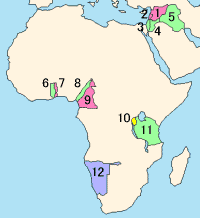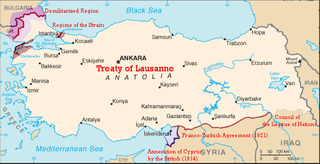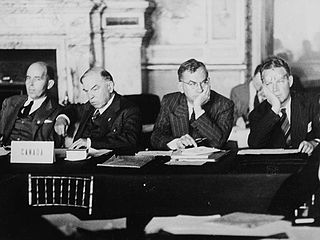
A League of Nations mandate was a legal status for certain territories transferred from the control of one country to another following World War I, or the legal instruments that contained the internationally agreed-upon terms for administering the territory on behalf of the League of Nations. These were of the nature of both a treaty and a constitution, which contained minority rights clauses that provided for the rights of petition and adjudication by the Permanent Court of International Justice.

The Treaty of Versailles was the most important of the peace treaties that brought World War I to an end. The Treaty ended the state of war between Germany and the Allied Powers. It was signed on 28 June 1919 in the Palace of Versailles, exactly five years after the assassination of Archduke Franz Ferdinand, which led to the war. The other Central Powers on the German side signed separate treaties. Although the armistice, signed on 11 November 1918, ended the actual fighting, it took six months of Allied negotiations at the Paris Peace Conference to conclude the peace treaty. The treaty was registered by the Secretariat of the League of Nations on 21 October 1919.

The Treaty of Lausanne was a peace treaty negotiated during the Lausanne Conference of 1922–23 and signed in the Palais de Rumine, Lausanne, Switzerland, on 24 July 1923. The treaty officially settled the conflict that had originally existed between the Ottoman Empire and the Allied French Republic, British Empire, Kingdom of Italy, Empire of Japan, Kingdom of Greece, and the Kingdom of Romania since the onset of World War I. The original text of the treaty is in French. It was the result of a second attempt at peace after the failed and unratified Treaty of Sèvres, which aimed to divide Ottoman lands. The earlier treaty had been signed in 1920, but later rejected by the Turkish national movement who fought against its terms. As a result of Greco-Turkish War, İzmir was retrieved and Armistice of Mudanya was signed in October 1922. It provided for the Greek-Turkish population exchange and allowed unrestricted civilian passage through the Turkish Straits.

The San Remo conference was an international meeting of the post-World War I Allied Supreme Council as an outgrowth of the Paris Peace Conference, held at Villa Devachan in Sanremo, Italy, from 19 to 26 April 1920. The San Remo Resolution passed on 25 April 1920 determined the allocation of Class "A" League of Nations mandates for the administration of three then-undefined Ottoman territories in the Middle East: "Palestine", "Syria" and "Mesopotamia". The boundaries of the three territories were "to be determined [at a later date] by the Principal Allied Powers", leaving the status of outlying areas such as Zor and Transjordan unclear.

The Paris Peace Treaties were signed on 10 February 1947 following the end of World War II in 1945. The Paris Peace Conference lasted from 29 July until 15 October 1946. The victorious wartime Allied powers negotiated the details of peace treaties with Italy, Romania, Hungary, Bulgaria and Finland. The treaties allowed the defeated Axis powers to resume their responsibilities as sovereign states in international affairs and to qualify for membership in the United Nations.

The Treaty of San Francisco, also called the Treaty of Peace with Japan, re-established peaceful relations between Japan and the Allied Powers on behalf of the United Nations by ending the legal state of war and providing for redress for hostile actions up to and including World War II. It was signed by 49 nations on 8 September 1951, in San Francisco, California, U.S. at the War Memorial Opera House. Communist-controlled Soviet Union, Poland and Czechoslovakia, all part of the Soviet Bloc, refused to send representatives, as did India and Yugoslavia. Italy and "China" were not invited, the latter due to disagreements on whether the Republic of China or the People's Republic of China represented the Chinese people. Korea was also not invited due to a similar disagreement on whether South Korea or North Korea represented the Korean people.

The Treaty of Rapallo was an agreement signed on 16 April 1922 between the German Republic and Soviet Russia under which both renounced all territorial and financial claims against each other and opened friendly diplomatic relations. The treaty was negotiated by Russian Foreign Minister Georgi Chicherin and German Foreign Minister Walther Rathenau. It was a major victory for Russia especially and also Germany, and a major disappointment to France and Great Britain. The term "spirit of Rapallo" was used for an improvement in friendly relations between Germany and Russia.

The aftermath of World War I saw drastic political, cultural, economic, and social change across Eurasia, Africa, and even in areas outside those that were directly involved. Four empires collapsed due to the war, old countries were abolished, new ones were formed, boundaries were redrawn, international organizations were established, and many new and old ideologies took a firm hold in people's minds. World War I also had the effect of bringing political transformation to most of the principal parties involved in the conflict, transforming them into electoral democracies by bringing near-universal suffrage for the first time in history, as in Germany, Great Britain, and Turkey.

The Paris Peace Conference was the formal meeting in 1919 and 1920 of the victorious Allies after the end of World War I to set the peace terms for the defeated Central Powers. Dominated by the leaders of Britain, France, the United States and Italy, it resulted in five treaties that rearranged the map of Europe and parts of Asia, Africa and the Pacific Islands and imposed financial penalties. Germany and the other losing nations had no voice which gave rise to political resentments that lasted for decades.

The Little Entente was an alliance formed in 1920 and 1921 by Czechoslovakia, Romania and the Kingdom of Serbs, Croats and Slovenes with the purpose of common defense against Hungarian revanchism and the prospect of a Habsburg restoration. France supported the alliance by signing treaties with each member country. The rapid growth of German power caused its collapse in 1938, and it never went into wartime operation.

The Treaty of Sèvres was a 1920 treaty signed between the Allies of World War I and the Ottoman Empire. The treaty ceded large parts of Ottoman territory to France, the United Kingdom, Greece and Italy, as well as creating large occupation zones within the Ottoman Empire. It was one of a series of treaties that the Central Powers signed with the Allied Powers after their defeat in World War I. Hostilities had already ended with the Armistice of Mudros.
Article 231, often known as the War Guilt Clause, was the opening article of the reparations section of the Treaty of Versailles, which ended the First World War between the German Empire and the Allied and Associated Powers. The article did not use the word "guilt" but it served as a legal basis to compel Germany to pay reparations for the war.

The partition of the Ottoman Empire was a geopolitical event that occurred after World War I and the occupation of Constantinople by British, French and Italian troops in November 1918. The partitioning was planned in several agreements made by the Allied Powers early in the course of World War I, notably the Sykes-Picot Agreement, after the Ottoman Empire had joined the Ottoman–German Alliance. The huge conglomeration of territories and peoples that formerly comprised the Ottoman Empire was divided into several new states. The Ottoman Empire had been the leading Islamic state in geopolitical, cultural and ideological terms. The partitioning of the Ottoman Empire after the war led to the domination of the Middle East by Western powers such as Britain and France, and saw the creation of the modern Arab world and the Republic of Turkey. Resistance to the influence of these powers came from the Turkish National Movement but did not become widespread in the other post-Ottoman states until the period of rapid decolonization after World War II.
Minority Treaties refer to the treaties, League of Nations Mandates, and unilateral declarations made by countries applying for membership in the League of Nations and United Nations. Most of the treaties entered into force as a result of the Paris Peace Conference.
The Agreement between the Allied and Associated Powers with Regard to the Contribution to the Cost of Liberation of the Territories of the Former Austro-Hungarian Monarchy was concluded on 10 September 1919 and complemented the Saint-Germain peace treaty with Austria.
The U.S.–Austrian Peace Treaty is a peace treaty between the United States and Austria, signed in Vienna on August 24, 1921, in the aftermath of the First World War. This separate peace treaty was required because the United States Senate refused to advise and consent to the ratification of the multilateral Treaty of Saint-Germain-en-Laye of 1919.
An agreement was signed in Beijing on May 20, 1921, between the German and the Chinese governments to restore peaceful relations after the First World War. The main reason for the treaty was that the Chinese government had refrained from signing the Treaty of Versailles since it granted the Japanese government control over Chinese territory, the formerly-German concession of Shandong. The agreement was beneficial for both sides by leading to cooperation between the two governments in the military field that lasted until the German government became aligned with the Japanese government on the eve of the Second World War.
The U.S.–German Peace Treaty was a peace treaty between the U.S. and the German governments. It was signed in Berlin on August 25, 1921 in the aftermath of World War I. The main reason for the conclusion of that treaty was the fact that the U.S. Senate did not consent to ratification of the multilateral peace treaty signed in Versailles, thus leading to a separate peace treaty. Ratifications were exchanged in Berlin on November 11, 1921, and the treaty became effective on the same day. The treaty was registered in League of Nations Treaty Series on August 12, 1922.
The Treaty of Friendship, Commerce and Consular Relations between Germany and the United States of America was an agreement for the improvement of relations between the US and German governments, signed in Washington, D.C. on December 8, 1923. The US Senate advised and consented to ratify on February 10, 1925. Ratifications were exchanged in Washington on October 14, 1925, and the treaty became effective on the same day. It was registered in League of Nations Treaty Series on August 3, 1926.

The Mandate for Palestine was a League of Nations mandate for British administration of the territories of Palestine and Transjordan, both of which had been conceded by the Ottoman Empire following the end of World War I in 1918. The mandate was assigned to Britain by the San Remo conference in April 1920, after France's concession in the 1918 Clemenceau–Lloyd George Agreement of the previously-agreed "international administration" of Palestine under the Sykes–Picot Agreement. Transjordan was added to the mandate after the Arab Kingdom in Damascus was toppled by the French in the Franco-Syrian War. Civil administration began in Palestine and Transjordan in July 1920 and April 1921, respectively, and the mandate was in force from 29 September 1923 to 15 May 1948.